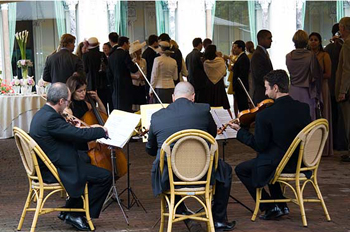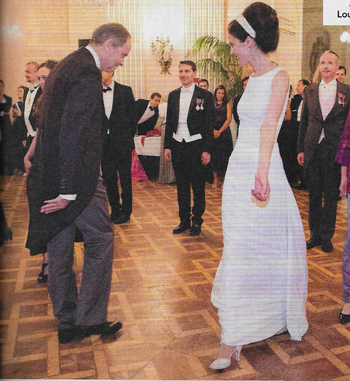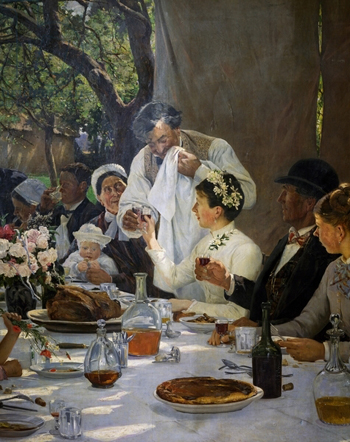Women and Men in Society
 |
 |
 |
 |
 |
 |
 |
A Brief Guide for Wedding Receptions - II
Music, Dancing & Toasting
In the last article, the proper tone of sacrality that should imbue the Catholic marriage reception was addressed. That same tone should be reflected in the
music, dancing and toasts.
Proper music to be played
In a homily on marriage, St. John Chrysostom advises: "Let them shun the immodest music and dancing that are currently so fashionable. I am aware that many people think me ridiculous for giving such advice; but if you listen to me, you will understand more and more the advantages of a sober lifestyle as time goes on. You will no longer laugh at me, but will laugh instead at the way people live now like silly children or drunken men."
 A general rule in selection is to use music with lyrics that are poetic without being mundane or insipid, that draw the mind towards higher things (not the world or passions), and that have a subservient rhythm and pleasing melody. The music can reflect a Catholic aspect of the couple's culture or family history.
A general rule in selection is to use music with lyrics that are poetic without being mundane or insipid, that draw the mind towards higher things (not the world or passions), and that have a subservient rhythm and pleasing melody. The music can reflect a Catholic aspect of the couple's culture or family history.
The selections for the reception can be classical or folk music. Many cultures have varied traditional songs that are suitable for weddings, with a wide range of instrumental music available.
It is advised to never use popular music – rock, pop, R&B (rhythm & blues), jazz, Latin genres, and even some country music, as it heavily incorporates the use of rhythm and percussion, which incites the passions. Such music is not recommended since it could invite people to dance. Swing music is also innappropriate because it is derived from jazz and often leads to extravagant and immodest movements. It behooves one to remember that the Church has also condemned swing dancing.
Instead of a DJ, consider hiring a string quartet, harpist or brass quintet for a more refined, dignified and elegant touch to your wedding. If this is not financially feasible, you can create a playlist of your own selections, connect them to your sound system, and set the playlist on repeat to avoid silent space. The volume of your music should be high enough for your guests to hear and enjoy, yet low enough to encourage conversation among everyone.
Types of dancing
A wedding reception serves to celebrate the newfound union of the couple, and if dancing takes place, it should assume a secondary aspect and not be the focal point of the joyous celebration. (See the Catholic position on dancing here, here and here).
 The rule is that the dancing must not incite the passions; thus proximity and body contact should be avoided. Folk dances that are innocent in nature may also be included. For example, the "circle dance" native to Greek and Middle Eastern cultures does not include body contact except for hands and is done in large groups. Men and women may also participate in separate dances for each gender.
The rule is that the dancing must not incite the passions; thus proximity and body contact should be avoided. Folk dances that are innocent in nature may also be included. For example, the "circle dance" native to Greek and Middle Eastern cultures does not include body contact except for hands and is done in large groups. Men and women may also participate in separate dances for each gender.
Dancing may or may not be a part of the wedding reception. It is perfectly acceptable for a couple not to have dancing at their reception. Many couples who prefer to avoid the problem of modern dancing schedule their weddings in the early afternoon (not in the early evening) or do not include any open space at their reception venue that guests might use for dancing.
Many Catholic couples choose to maintain the modern tradition of the "first dance" commonly done by the newlyweds and the father-daughter/mother-son dance that follows. But let them take care that it not be slow or sensual in nature. Some couples choose to have these first dances and then close the floor to dancing for the guests. The couple should realize it is they who are setting the rules and norms at their wedding, and they do not need to comply to modern tastes or demands. No amount of family pressure should force a couple to include dancing against their wishes. In many ways it is better for serious couples who want to glorify God to not include any dancing.
Alcohol
To avoid excesses in drinking, it is advisable to plan the wedding and reception in the early afternoon. It is prudent to have attendants who serve the wine versus an open bar that encourages self-serving, which causes some guests to over-indulge.
Red and white wines are always a suitable choice for receptions, allowing guests to take "sips" and not "shots." Hard liquor may be avoided or reserved to offer in moderate amounts after the food has been served and when guests have already eaten sufficiently enough to not be susceptible to drunkenness. Avoid making your reception too long as this will also encourage heavy drinking.
Toasting the newlyweds
 It is good to ask your bridal party to prepare toasts ahead of time and have the wedding coordinator or even the officiating priest approve them. This precaution allows the couple to avoid the vulgarity and hilarity of the spontaneous toast that has become the norm in our days.
It is good to ask your bridal party to prepare toasts ahead of time and have the wedding coordinator or even the officiating priest approve them. This precaution allows the couple to avoid the vulgarity and hilarity of the spontaneous toast that has become the norm in our days.
A word must be said on "clinking the glass" at wedding receptions - a recent custom whereby guests tap their glasses with a knife and call for the couple to publicly kiss each other. Although the couple is now wedded, kissing still remains an intimate gesture that should not be made in public. As such, it would be imprudent for the couple to follow their guests' wishes and kiss each other on the lips, although it is proper for the groom to kiss the bride on her cheek or forehead. The couple may also respond by tapping their wine glasses together and taking a sip to please the guests.
In summation
In the many details of a wedding reception to consider when planning, what is most important is to remember that this gathering is a means to entertain guests who are there to celebrate with the newlyweds the Sacrament of Marriage. Therefore, the reception, like the ceremony itself, should serve to edify others with the good practices and customs of Catholic tradition and stand as a testimony to the couple's love for God, the Church and each other.
These practical suggestions are meant to assist others who are earnestly seeking to please Our Lord and Our Lady in their newly-married lives. As a final note, I strongly urge all engaged couples to read the text of the Marriage Service and Nuptial Mass to provide them a larger framework from which to work.
Taken from the book of Tobias, the Introit reads: "May the God of Israel join you together: and may He be with you, who was merciful to two only children: and now, O Lord, make them bless Thee more fully. Blessed are all they that fear the Lord, that walk in His ways."

Posted November 20, 2017
Proper music to be played
In a homily on marriage, St. John Chrysostom advises: "Let them shun the immodest music and dancing that are currently so fashionable. I am aware that many people think me ridiculous for giving such advice; but if you listen to me, you will understand more and more the advantages of a sober lifestyle as time goes on. You will no longer laugh at me, but will laugh instead at the way people live now like silly children or drunken men."

A simple reception for newlyweds in days past
The selections for the reception can be classical or folk music. Many cultures have varied traditional songs that are suitable for weddings, with a wide range of instrumental music available.
It is advised to never use popular music – rock, pop, R&B (rhythm & blues), jazz, Latin genres, and even some country music, as it heavily incorporates the use of rhythm and percussion, which incites the passions. Such music is not recommended since it could invite people to dance. Swing music is also innappropriate because it is derived from jazz and often leads to extravagant and immodest movements. It behooves one to remember that the Church has also condemned swing dancing.
Instead of a DJ, consider hiring a string quartet, harpist or brass quintet for a more refined, dignified and elegant touch to your wedding. If this is not financially feasible, you can create a playlist of your own selections, connect them to your sound system, and set the playlist on repeat to avoid silent space. The volume of your music should be high enough for your guests to hear and enjoy, yet low enough to encourage conversation among everyone.
Types of dancing
A wedding reception serves to celebrate the newfound union of the couple, and if dancing takes place, it should assume a secondary aspect and not be the focal point of the joyous celebration. (See the Catholic position on dancing here, here and here).

An elegant dance without touching at a Vienna wedding
Dancing may or may not be a part of the wedding reception. It is perfectly acceptable for a couple not to have dancing at their reception. Many couples who prefer to avoid the problem of modern dancing schedule their weddings in the early afternoon (not in the early evening) or do not include any open space at their reception venue that guests might use for dancing.
Many Catholic couples choose to maintain the modern tradition of the "first dance" commonly done by the newlyweds and the father-daughter/mother-son dance that follows. But let them take care that it not be slow or sensual in nature. Some couples choose to have these first dances and then close the floor to dancing for the guests. The couple should realize it is they who are setting the rules and norms at their wedding, and they do not need to comply to modern tastes or demands. No amount of family pressure should force a couple to include dancing against their wishes. In many ways it is better for serious couples who want to glorify God to not include any dancing.
Alcohol
To avoid excesses in drinking, it is advisable to plan the wedding and reception in the early afternoon. It is prudent to have attendants who serve the wine versus an open bar that encourages self-serving, which causes some guests to over-indulge.
Red and white wines are always a suitable choice for receptions, allowing guests to take "sips" and not "shots." Hard liquor may be avoided or reserved to offer in moderate amounts after the food has been served and when guests have already eaten sufficiently enough to not be susceptible to drunkenness. Avoid making your reception too long as this will also encourage heavy drinking.
Toasting the newlyweds

The traditional toast to the bride - without a kiss
A word must be said on "clinking the glass" at wedding receptions - a recent custom whereby guests tap their glasses with a knife and call for the couple to publicly kiss each other. Although the couple is now wedded, kissing still remains an intimate gesture that should not be made in public. As such, it would be imprudent for the couple to follow their guests' wishes and kiss each other on the lips, although it is proper for the groom to kiss the bride on her cheek or forehead. The couple may also respond by tapping their wine glasses together and taking a sip to please the guests.
In summation
In the many details of a wedding reception to consider when planning, what is most important is to remember that this gathering is a means to entertain guests who are there to celebrate with the newlyweds the Sacrament of Marriage. Therefore, the reception, like the ceremony itself, should serve to edify others with the good practices and customs of Catholic tradition and stand as a testimony to the couple's love for God, the Church and each other.
These practical suggestions are meant to assist others who are earnestly seeking to please Our Lord and Our Lady in their newly-married lives. As a final note, I strongly urge all engaged couples to read the text of the Marriage Service and Nuptial Mass to provide them a larger framework from which to work.
Taken from the book of Tobias, the Introit reads: "May the God of Israel join you together: and may He be with you, who was merciful to two only children: and now, O Lord, make them bless Thee more fully. Blessed are all they that fear the Lord, that walk in His ways."

Posted November 20, 2017
______________________
______________________








